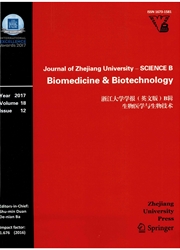

 中文摘要:
中文摘要:
目的:探讨特定高温和强光逆境下番茄叶片中的环式电子传递(CEF)和线性电子传递(LEF)的光保护机制。创新点:通过引入电子抑制剂的方法系统分析了CEF和LEF对亚高温强光胁迫的响应。方法:将品种为"辽园多丽"的番茄幼苗(n=160)平均分成四组(表1):组1,于常温常光照25°C,500μmol/(m2·s)条件下培养并作为对照;组2,叶片喷施蒸馏水并在亚高温强光35°C,1000μmol/(m2·s)(HH)条件下培养;组3,HH条件下叶片喷施100μmol/L敌草隆(DCMU,CEF抑制剂);组4,HH条件下叶片喷施60μmol/L甲基紫精(MV,LEF抑制剂)。在处理5 d及恢复10 d期间,分别测定番茄幼苗叶片的光能吸收、激发能分配、光系统活性、类囊体膜完整性和ATP酶活性等指标。结论:CEF和LEF通过一定程度上改善叶片光能吸收及激发能分配,并且维持类囊体膜较高完整性和ATP酶活性,从而维持光系统活性并减少光抑制和光破坏程度。
 英文摘要:
英文摘要:
Objective: To evaluate the possible photoprotection mechanisms of cyclic and linear electron flux (CEF and LEF) under specific high temperature and high light (HH) stress. Methods: Six-leaf-stage tomato seedlings ("Liaoyuanduoli", n=160) were divided into four parts: Part 1, served as control under 25 ℃, 500 pmol/(m2-s); Part 2, spayed with distilled water (H20) under 35 ℃, 1000 pmol/(m2.s) (HH); Part 3, spayed with 100 μmol/L diuron (DCMU, CEF inhibitor) under HH; Part 4, spayed with 60 pmol/L methyl viologen (MV, LEF inhibitor) under HH. Energy conversion, photosystem I (PSI), and PSII activity, and trans-thylakoid membrane proton motive force were monitored during the treatment of 5 d and of the recovering 10 d. Results: HH decreased photochemical reaction dissipation (P) and the maximal photochemical efficiency of PSII (Fv/Fm), and increased the excitation energy distribution coefficient of PSII (,8); DCMU and MV aggravated the partition imbalance of the excitation energy (y) and the photoinhibition degree. With prolonged DCMU treatment time, electron transport rate and quantum efficiency of PSI (ETR= and Y1) significantly decreased whereas acceptor and donor side limitation of PSI (YNA and YND) increased. MV led to a significant decline and accession of yield of regulated and non-regulated energy Y NPQ and YNO, respectively. Membrane integrity and ATPase activity were reduced by HH stress, and DCMU and MV enhanced inhibitory actions. Conclusions: The protective effects of CEF and LEF were mediated to a certain degree by meliorations in energy absorption and distribution as well as by maintenance of thylakoid membrane integrity and ATPase activity.
 同期刊论文项目
同期刊论文项目
 同项目期刊论文
同项目期刊论文
 期刊信息
期刊信息
